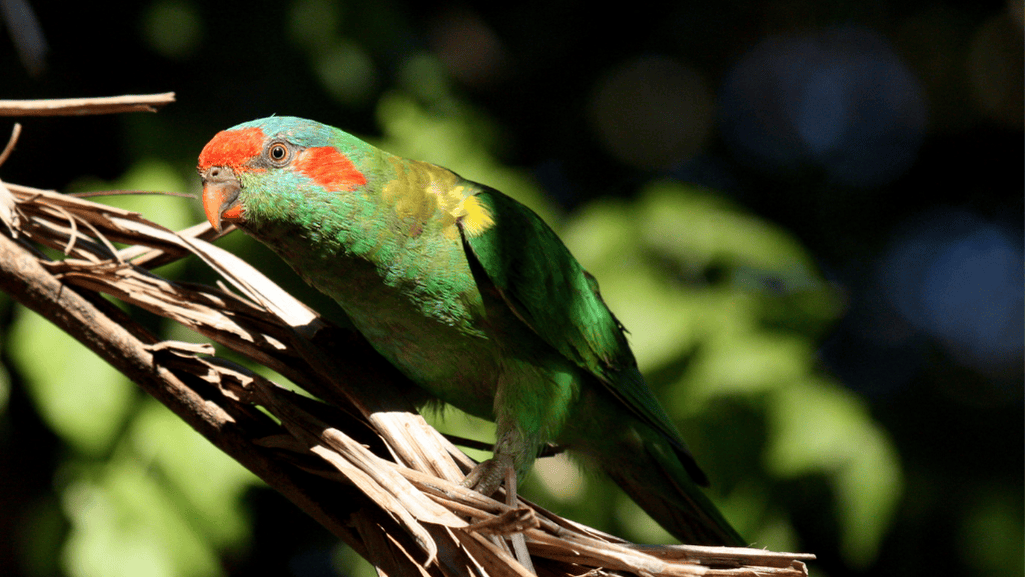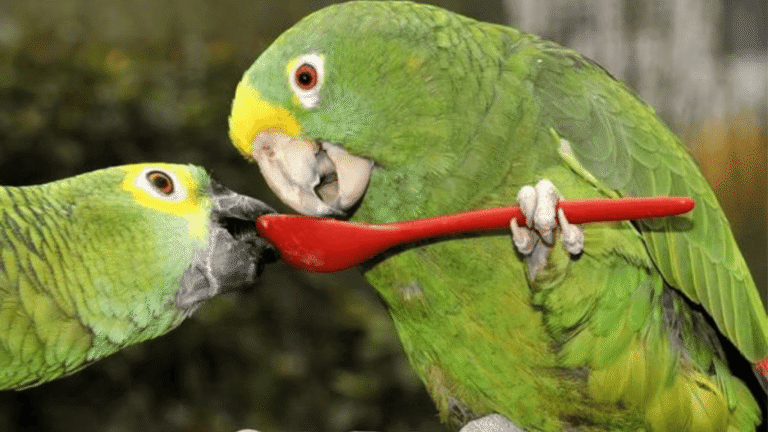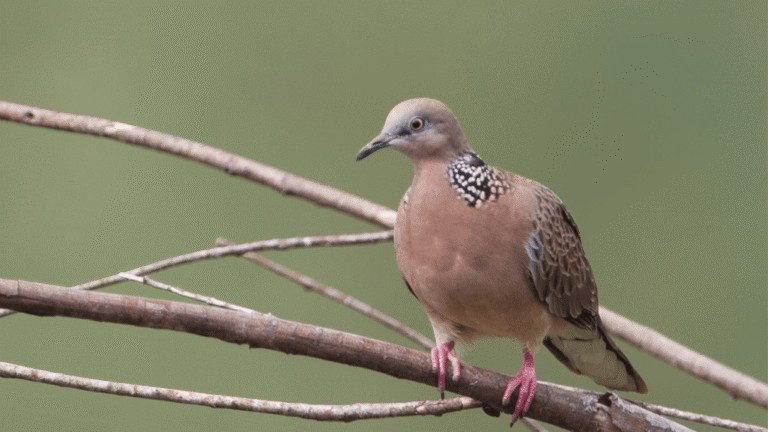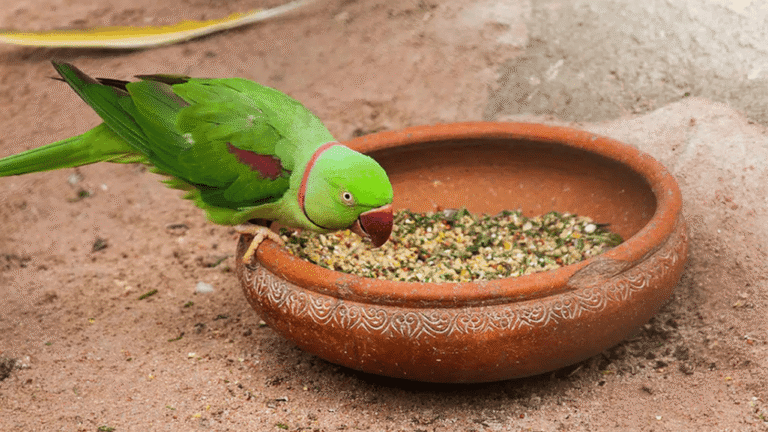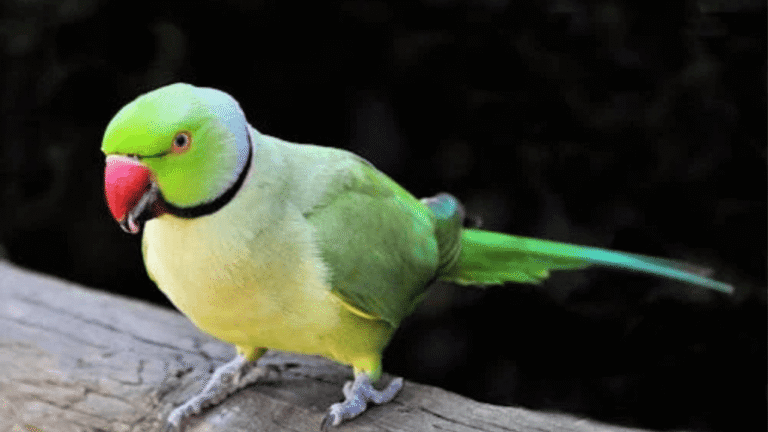The Musk Lorikeet (Glossopsitta concinna) is known for its bright colors and musky smell. These birds are full of life and interest many bird lovers around the world. They are bigger than some lorikeets but smaller than others, making them special in southeastern Australia.
These birds live in open woodlands and cities, eating mostly pollen and nectar. They need eucalypt forests to survive. With a “Least Concern” status, they are doing well in cities. Learning about the Musk Lorikeet helps us understand these birds and why we need to protect them.
Key Takeaways
- The Musk Lorikeet is recognized for its vibrant green plumage with signature yellow and red markings.
- It thrives in a habitat ranging from eucalypt forests to urban parks in southeastern Australia.
- Nomadic by nature, their movements are guided by the availability of food sources.
- A diet rich in nectar, pollen, seeds, fruits, and insects sustains these birds.
- Musk Lorikeets are social, forming large flocks and interacting with other bird species.
- Conservation status is stable, with the species adapting well to urbanized areas.
- Breeding from August to January, nests are found high in eucalyptus trees.
Discovering the Vivid World of the Musk Lorikeet
The Musk Lorikeet is a standout in the colorful parrot world of Australian wildlife. It catches the eye with its bright colors and lively actions. This avian species thrives in many places, from wild areas to city homes.
In southeastern Australia, Musk Lorikeets love to search for food in Eucalyptus tree blossoms. They are experts at getting nectar and pollen, showing off their skill and quickness.
Musk Lorikeets prefer places with lots of flowers, but they also live in cities. They enjoy gardens and parks, adding to their diet with nectar from local plants. This shows how flexible they are, bringing beauty to urban areas for people to see.
To understand Musk Lorikeets better, let’s look at how they compare to other parrots in South Australia. Here’s a table showing different parrots and how they find food:
| Species | Foraging Behavior | Primary Diet |
|---|---|---|
| Musk Lorikeet | Agile nectar and pollen extraction from blossoms | Nectar, Pollen |
| Rainbow Lorikeet | Pair bonding, nested foraging in tree hollows | Nectar, Pollen, Fruits |
| Red-rumped Parrot | Ground foraging in open parklands | Seeds, Fruits |
| Galah | Large ground flocks in noisy congregations | Seeds, Nuts, Berries |
| Yellow-tailed Black Cockatoo | Extracts seeds from native tree cones | Seeds, Insects |
If you want to see or learn about Musk Lorikeets and other parrots, check out birding tours on Australian Wildlife Journeys. These sites share great tips on where and how to see Musk Lorikeets and other birds. They help us appreciate and protect these amazing birds.
Distinguishing Features of the Musk Lorikeet
The Musk Lorikeet is a colorful bird in the parrot family. It has avian physical characteristics that are interesting and help in telling them apart. These traits are important from the Juvenile Musk Lorikeet to the adult plumage.
Size, Weight and Subspecies Variations
The Musk Lorikeet is about 22 cm long, making it smaller than some lorikeets. It weighs 60-90 grams, which is light and perfect for flying. There are two subspecies: G.c.concinna and G.c.didimus. They differ mainly in their crown colors, with G.c.didimus having less blue.
Adult and Juvenile Color Differences
The Musk Lorikeet’s colors change as it grows up. Adults have a bright red forehead and eye stripe, with a blue crown. This color can vary between males and females and subspecies. Young Musk Lorikeets have paler colors and a brown bill and eyes, showing they are still growing.
| Age Group | Forehead Color | Crown Color | Bill Color |
|---|---|---|---|
| Juvenile | Pale Red | Pale Blue/Brown | Brown |
| Adult | Vivid Red | Blue (Varies) | Greyish-Black |
The Musk Lorikeet’s growth from young to adult is interesting. It shows how they adapt and vary. Watching their color patterns change or seeing what makes each subspecies unique is amazing. It shows the Musk Lorikeet’s beauty and complexity.
Behavioral Traits and Habitat Preferences
The Musk Lorikeet shows a colorful mix of behaviors and habitat choices. They are a lively example of Musk Lorikeet social behavior in their natural and adapted homes. They love eucalyptus woodlands for their food and safety.
In their favorite eucalyptus woodlands, Musk Lorikeets live in big groups. These groups help them find food and stay safe from predators. They also keep warm in cold months. Their group work shows how well they choose their homes.
Their social life is fascinating. Musk Lorikeet social behavior shines during meals. They eat together, strengthening their bonds and sharing food tips.
But they don’t just like eucalyptus woodlands. In cities, they adapt well too. They can be found in parks and gardens, where they find food in ornamental trees and shrubs. This shows they can live in different places.
These birds do more than just live in their ecosystems. They help pollinate native plants, especially in eucalyptus woodlands. By moving between trees, they help plants reproduce. This shows how important it is to protect their homes.
For more on similar species, check out the Papuan Lorikeet. It talks about how behavior, habitat, and conservation are connected.
In summary, Musk Lorikeets teach us about living in harmony with nature. Their way of life in eucalyptus woodlands adds to the area’s beauty and biodiversity.
Feeding Habits: What Do Musk Lorikeets Eat?
Musk Lorikeets mainly eat nectar and pollen. This is because they are nectarivorous birds. Their special tongues help them get nectar from flowers, making up their natural diet.
The Role of Nectar and Pollen in Their Diet
Musk Lorikeets use their tongues to get nectar from Eucalyptus flowers. This nectar gives them sugars and proteins. It’s what makes them different from other birds that forage for pollen.
Importance of Fruits and Seeds for Nutritional Balance
But Musk Lorikeets also eat fruits and seeds. This mix is important for their health. It gives them vitamins and minerals that nectar doesn’t have.
| Diet Component | Percentage | Benefit |
|---|---|---|
| Nectar and Pollen | 70% | Main energy source, offers proteins |
| Fruits and Seeds | 20% | Supplies vitamins and minerals |
| Foliage and Other | 10% | Supplements diet, enriches foraging activity |
They also eat fresh foliage and sometimes insects. This makes their diet more natural. Brands like Wombaroo and Passwells make food for them that’s close to what they eat in the wild.
Knowing what Musk Lorikeets eat helps keep them healthy. It also helps make their diet in captivity more natural. This can really help their wellbeing and how long they live.
Understanding the Vocalizations of Musk Lorikeets
Musk lorikeets make sounds that are more than just noise. They are a key part of how these birds talk to each other. Their calls, especially when they eat nectar, tell us a lot about their mood and behavior.
Their calls help them stay in touch with each other. They also help figure out who’s who in a group. This is important for finding a mate or defending their territory. Plus, their calls warn others of danger or show where food is.
It’s fascinating how their calls change depending on the situation. During mating, they make more noise. When they’re moving around or facing threats, their calls change too. This shows their calls are a complex language we’re still learning about.
To show how different musk lorikeet calls are, let’s compare them with Rainbow Lorikeets. Both are known for their loud sounds:
| Characteristic | Musk Lorikeet | Rainbow Lorikeet |
|---|---|---|
| Call Description | Rollling metallic screeches | Loud, high-pitched chattering |
| Primary Purpose | Social cohesion, feeding, and alert | Social interaction, territory defense |
| Behavioral Context | Feeding on nectar, flock movement | Aggressive during mating, defending territory |
| Vocalization Variety | Varied calls based on context and threat level | Consistently loud with variations for mating |
Learning about how musk lorikeets communicate is not just interesting. It also helps us understand their world better. As scientists keep studying, we learn more about these amazing birds and their place in nature.
Reproduction: Breeding Habits of the Musk Lorikeet
The Musk Lorikeet breeding process is fascinating. It’s tied to environmental cues for the best conditions for their young. Knowing about avian nesting and mate selection helps in conservation and for bird lovers.
The Musk Lorikeets breed from August to January. They focus on finding the right mate and building a nest. This is a crucial time for them to prepare for their babies.
- Nesting Site Selection: Musk Lorikeets like hollows in old trees near water for their nests. These spots are safe and stable.
- Mate Selection: Choosing a mate is key for genetic diversity and survival. Pairs often stay together for many breeding seasons.
After finding a good nest, the female lays two eggs. She incubates them for 22-24 days. The need for tree hollows for nesting highlights the importance of saving old trees.
Preserving natural habitats is essential for maintaining the ecological cycles of species like the Musk Lorikeet.
After the eggs hatch, both parents feed the chicks. The chicks stay in the nest for up to seven weeks. They grow fast, learning to fly and become independent.
It’s important to keep the birds safe during breeding. Risks like Psittacosis need to be managed. Regular health checks and keeping the aviary calm help prevent these problems.
The reproductive cycle of the Musk Lorikeet shows the complexity of bird life. Conservationists and bird lovers can help by keeping their habitat safe during breeding.
Conservation Efforts and the Musk Lorikeet’s Status
The Musk Lorikeet is a stable species known for its bright green and red colors. It thrives in various habitats in Australia. The Musk Lorikeet population is a success story of wildlife conservation and environmental protection.
These birds live in eucalypt forests and even in cities like Melbourne and Sydney. They have adapted well to urban life. This shows how birds can thrive in cities with the right support.
To understand the Musk Lorikeet’s status and conservation efforts, here are some key facts:
| Musk Lorikeet Fact | Details |
|---|---|
| World Population | Unknown, stable |
| Longevity in Wild | 15-25 years |
| Conservation Status | Least Concern (IUCN) |
| Habitat Range | SE Australia to Tasmania and regional cities |
| Threats | Minimal, except potential risks in alpine regions |
| Diet | Nectar, pollen, fruits, and seeds predominantly |
| Captive Status | Rare outside of Australia, some present in US and UK aviaries |
For more on caring for Musk Lorikeets and the effects of hybridization, check out this guide. It helps keep these birds healthy and supports wildlife conservation and environmental protection.
The Musk Lorikeet’s stable status shows the success of conservation efforts. It also highlights the need for ongoing monitoring and management to protect them for the future.
Maintaining a Healthy Environment for Captive Musk Lorikeets
To keep Musk Lorikeets healthy, you need to focus on aviary design and enrichment for captive birds. This ensures their parrot welfare and meets their specialized nectar diet needs.
Aviary Requirements and Enrichment Activities
Good aviary design is key for Musk Lorikeets in captivity. It should mimic their natural habitat as much as possible. This means lots of flying space and safe, fun things to do.
Aviaries should have floor drains or cages over solid floors. They should also have misters or shallow water bowls for bathing. This helps meet their dietary needs.
Enrichment is also very important. It includes toys that make noise, non-destructive objects, and chewable items. These activities keep the birds’ minds sharp and reduce stress. This leads to a happier, more social bird.
Nutritional Needs and Diet in Captivity
A Musk Lorikeet’s diet should be similar to their natural one, with a specialized nectar diet. About 70% of their food should be a high-quality wet mix made for lorikeets. This mix meets their special nutritional needs.
The rest of their diet should be fresh fruits and veggies. These provide important vitamins and nutrients for their captive bird nutrition.
It’s important to offer a variety of fresh foods like lemon tree leaves, milk thistle, or dandelions. This ensures they get all the nutrients they need for good health and a long life.
Watching their diet closely is crucial. Wet mixes should not sit out for more than three hours to avoid bacterial growth.
By focusing on these details, you can keep Musk Lorikeets healthy and happy. This ensures they live vibrant, full lives in captivity.
Interesting Facts and Unique Characteristics of Musk Lorikeets
The Musk Lorikeet, native to Australia, is a bird full of avian peculiarities that fascinate bird enthusiasts globally. They have a musky scent, which is where they get their name. Their bright colors and special tongues for eating nectar and pollen make them stand out.
These birds are not just beautiful; they are also important for their ecosystems. They help pollinate Eucalypt trees with their diet of nectar and pollen. As they move around, they help these trees reproduce, keeping their forests healthy.
For those who keep Musk Lorikeets as pets, knowing their needs is key. This knowledge helps them live long, healthy lives. It’s important to feed them right, keep them worm-free, and watch for infections. Learn more about caring for them here.
| Care Aspect | Why It’s Important |
|---|---|
| Nectar Replacement Diet | Addresses their specific nutritional needs as nectar feeders. |
| Fresh Fruits & Vegetables Daily | Provides essential vitamins and minerals. |
| Bi-annual Worming | Prevents parasitic infections which can compromise health. |
| Avoid Harmful Foods | Prevents toxic reactions and potential health hazards. |
| Regular Health Monitoring | Early detection and treatment of potential health issues. |
Musk Lorikeets are just as captivating in captivity as they are in the wild. They have playful personalities and complex social behaviors. Giving them toys and interacting with them can keep them happy and healthy.
The charm of Musk Lorikeet trivia draws in bird enthusiasts from all over. It deepens their appreciation for these unique avian peculiarities.
Conclusion
The Musk Lorikeet is a stunning bird that encourages us to appreciate birds and care for our environment. They grow up to 9 inches tall and have been in Australia for over a century. Their first sighting in captivity was in 1869.
These birds are adaptable, but we need to protect them. They can live for 12 to 20 years. They face health issues like Aspergillosis, but proper care can help.
Musk Lorikeets live in groups, sometimes with hundreds of birds together. They feed in pairs, showing loyalty and teamwork. They are skilled at finding food in the trees, needing lots of exercise to stay healthy.
Keeping Musk Lorikeets in captivity requires a special diet. They need wet foods like apples and spinach to stay healthy. The Musk Lorikeet’s story teaches us about the importance of protecting nature’s diversity.



